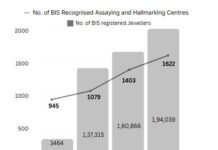Public Health Fraternity, School Students, Teachers & Parents appeal to the government to act against tobacco advertising and glamorization of tobacco usages on OTT platforms.
To safeguard children and youth from the detrimental tobacco advertisements on different over the counter (OTT) platforms, public health organizations, schools students, teachers and parents have urged the Government of India to act against tobacco advertising and the glamorization of tobacco use on such platforms.
A recent study published in the British Medical Journal (BMJ) titled ‘Tobacco imagery in on-demand streaming content popular among adolescents and young adults in India: implications for global tobacco control’ revealed that OTT platforms are flouting the Government of India regulations related to tobacco exposure imagery. The study evaluated tobacco depictions in ten television series available via on-demand streaming platforms including Netflix, Hulu, Hotstar, Amazon Prime among others. Incidents of tobacco use and tobacco brands in each series were counted, and compliance with Indian Laws was recorded.
The BMJ study further said that there is a rampant depiction of tobacco use and tobacco brand placements. The shows with tobacco depictions included both foreign-produced and Indian-produced series and most were rated for viewers below 18 years, thus targeting youth and children. Many of the series showed tobacco brands as well as close-ups of tobacco products and tobacco usages. None of the series included anti-tobacco static warning messages, anti-tobacco health spots, or audiovisual disclaimers about the ill-effects of tobacco use.
The implementing guidelines for Article 13 of the WHO Framework Convention on Tobacco Control (FCTC) recommends that parties should prohibit the use of tobacco brands or imagery in entertainment media and require anti-tobacco advertisements. India is a global leader in meeting these requirements of the WHO FCTC.
It is here to be noted that Section 5 of India’s Cigarettes and Other Tobacco Products Act (COTPA) imposes a complete ban on tobacco advertising and promotion in any form of media. Therefore, it is quite evident that Section 5 of COTPA is blatantly being violated by these OTT platforms.
Moreover, the 2012 Rules (G.S.R. 786(E)) notified under COTPA in pursuance of the prohibition on tobacco advertising requires a broadcaster of television programmes to display anti-tobacco disclaimers, spots, and messages in all films and television programmes depicting tobacco products or their use.
The BMJ study is limited to ten television series but it provides conclusive evidence that the streaming services are completely disregarding India’s high standards for restricting and containing tobacco depictions in the media. It is even the case that movies with tobacco depictions that include the appropriate anti-tobacco disclaimers, spots and messages when shown in cinemas or on cable networks, are made available on the streaming platforms without anti-tobacco messages.
This is of particular concern because on-demand streaming platforms are becoming increasingly popular in India, especially with young viewers. A 2019 study by KPMG reported that there were 325 million viewers of on-demand streaming platforms in India and that young people (age 15-24) spent an average of 70 minutes per day watching online video content.
Due to unprecedented events of COVID-19, people especially children and youth are spending more time on OTT platforms due to restrictions on movie halls. They are getting influenced by tobacco consumption shown in movies, series, and short films streamed on OTT platforms as at present, there are no regulations imposed on OTT platforms regarding tobacco consumption display.
In this phase where the dependency on online platforms has increased, understandably, young minds are getting attracted to such a dangerous portray of tobacco consumption openly by characters of different roles on various OTT platforms.
Furthermore, as per the National Cancer Registry Programme Report 2020, released by The Indian Council of Medical Research (ICMR) and the National Centre for Disease Informatics & Research (NCDIR), Bengaluru, in 2020 cancer cases in the country will be at 13.9 lakh and likely to increase to 15.7 lakhs by 2025, based on current trends. In 2020, tobacco-related cancers are estimated to contribute 3.7 lakhs (27.1 per cent) of the total cancer burden.
Moreover, according to sources, MoHFW has recently sent a letter to the Ministry of Electronics and Information Technology highlighted that the tobacco film rules are applicable to OTT platforms too and strict action may kindly be taken for prohibiting the depiction of tobacco use through streaming media in connection with the extant provisions under COTPA, 2003.
Draft Quote from Public Health – “The streaming media has become a haven for the promotion of tobacco use and this extensive promotion is undermining the government film rules and provisions discouraging tobacco use. We urged the government to take necessary action to ensure these online streaming platforms are compliant with COTPA, relevant rules, and any other applicable laws in order to protect the children from exposure to tobacco products display on such platforms”
A relevant study conducted in New Delhi showed that adolescents aged 12–16 years with high exposure to tobacco occurrences in Bollywood films were 2.3 times more likely to have ever used tobacco compared with adolescents with low exposure.
Teacher and Parent Quote – “It is shocking to see the glamorization of tobacco usages on such platforms. It is well-established fact that exposure to tobacco imagery in the media increases the likelihood of tobacco uptake in adolescents and young adults and that this relationship is causal.”
- As per the GATS data, Government of India 14.6% of 13–15 year old students in India use tobacco. As many as 11% of all male students surveyed were found to be users of smoking or smokeless tobacco, while 6% of female students used smokeless tobacco and 3.7% smoked tobacco
- Another study conducted by World Health Organization and Ministry of Health and Family Welfare, Govt. of India revealed that 76% of Indian movies had tobacco use shown in them and 52.2% of children in India who had their first smoke were influenced by tobacco use depicted in movies.













